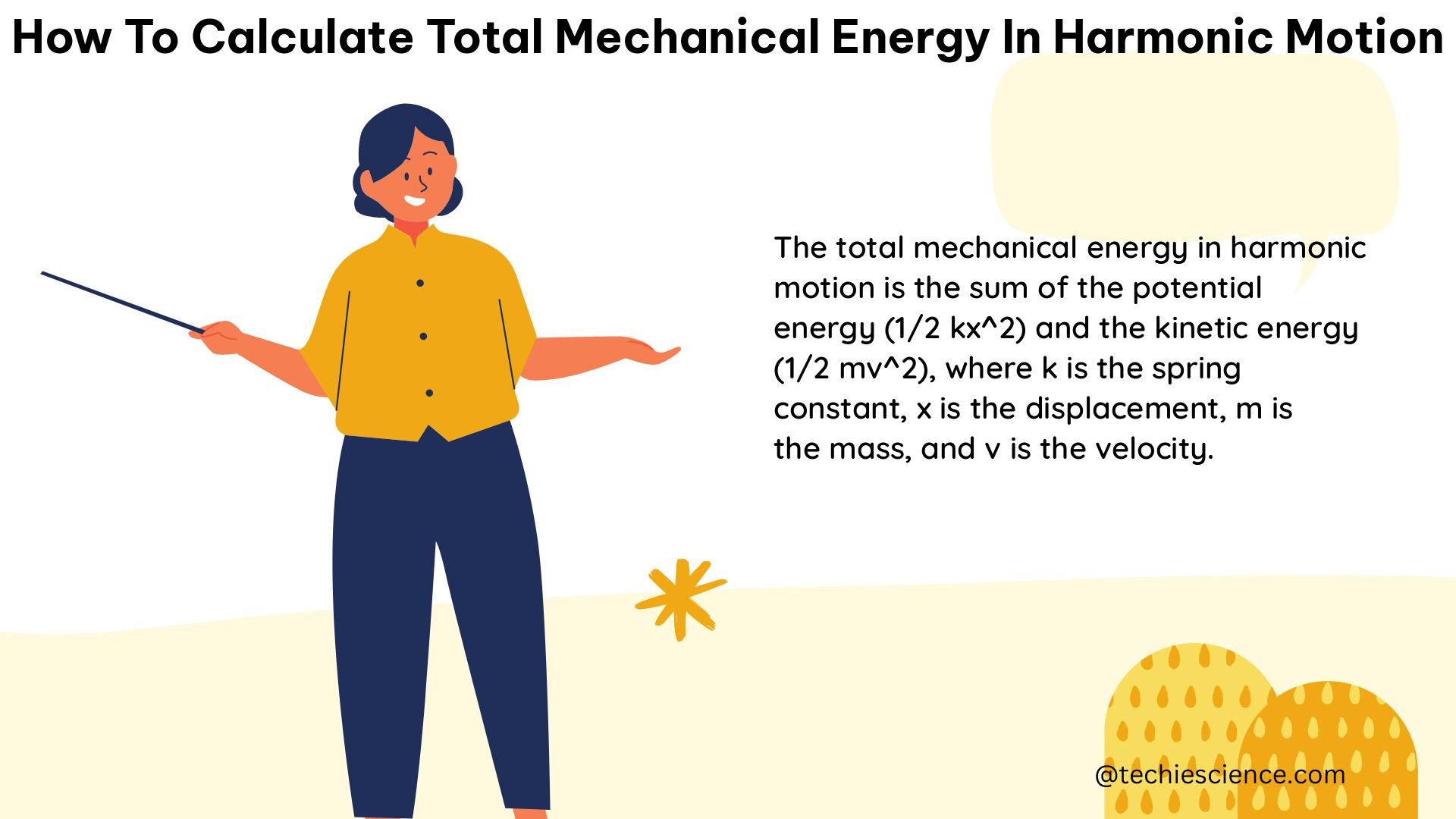The total mechanical energy in harmonic motion is the sum of the kinetic energy and the potential energy of the oscillating system. This is a crucial concept in physics, as it allows us to understand the energy transformations and conservation principles governing simple harmonic motion. In this comprehensive guide, we will delve into the step-by-step process of calculating the total mechanical energy in harmonic motion, providing you with a thorough understanding of the underlying principles and practical examples.
Understanding Simple Harmonic Motion
Simple harmonic motion (SHM) is a type of oscillatory motion where the restoring force is proportional to the displacement from the equilibrium position. This motion is often observed in systems involving springs, pendulums, and other oscillating systems. The position x(t) and velocity v(t) of an object in SHM can be described by the following equations:
x(t) = A cos(ωt + φ)
v(t) = -Aω sin(ωt + φ)
where:
– A is the amplitude of the oscillation
– ω is the angular frequency of the oscillation
– φ is the phase angle
Calculating Kinetic Energy in Harmonic Motion

The kinetic energy (K) of an object in simple harmonic motion is given by the following equation:
K = 1/2 mv^2
where:
– m is the mass of the object
– v is the velocity of the object
Substituting the expression for velocity in SHM, we get:
K = 1/2 mA^2 ω^2 sin^2(ωt + φ)
This equation tells us that the kinetic energy of the object varies sinusoidally with time, reaching a maximum at the points where the velocity is maximum (i.e., when the object is passing through the equilibrium position).
Calculating Potential Energy in Harmonic Motion
The potential energy (U) of an object in simple harmonic motion is typically the elastic potential energy stored in the spring or other restoring force. The equation for the elastic potential energy is:
U = 1/2 kx^2
where:
– k is the spring constant
– x is the displacement of the object from the equilibrium position
Substituting the expression for position in SHM, we get:
U = 1/2 kA^2 cos^2(ωt + φ)
This equation shows that the potential energy varies sinusoidally with time, reaching a maximum at the points where the displacement is maximum (i.e., at the turning points of the motion).
Calculating Total Mechanical Energy in Harmonic Motion
The total mechanical energy (E) of an object in simple harmonic motion is the sum of its kinetic energy and potential energy:
E = K + U
= 1/2 mA^2 ω^2 sin^2(ωt + φ) + 1/2 kA^2 cos^2(ωt + φ)
= 1/2 kA^2
This equation reveals an important property of simple harmonic motion: the total mechanical energy is constant and equal to half the product of the spring constant and the square of the amplitude.
Example Calculation
Let’s consider an example to illustrate the calculation of total mechanical energy in harmonic motion.
Suppose we have an 8 kg block attached to a spring with a spring constant of 35 N/m. At a certain instant, the block is displaced 0.03 m from the equilibrium position, and its velocity is 0.0627 m/s.
To calculate the total mechanical energy, we first need to find the kinetic energy and potential energy at this instant.
Kinetic energy:
K = 1/2 mv^2
= 1/2 (8 kg) (0.0627 m/s)^2
= 0.01575 J
Potential energy:
U = 1/2 kx^2
= 1/2 (35 N/m) (0.03 m)^2
= 0.01575 J
Now, the total mechanical energy is the sum of the kinetic and potential energies:
E = K + U
= 0.01575 J + 0.01575 J
= 0.0315 J
Therefore, the total mechanical energy of the system at this instant is 0.0315 J.
Additional Considerations
- The total mechanical energy remains constant throughout the motion, as long as there are no external forces or dissipative forces acting on the system.
- The maximum kinetic energy occurs when the object is passing through the equilibrium position, and the maximum potential energy occurs at the turning points of the motion.
- The total mechanical energy can be expressed in terms of the amplitude (A) and the angular frequency (ω) as:
E = 1/2 kA^2 - The total mechanical energy can also be expressed in terms of the maximum kinetic energy (K_max) or the maximum potential energy (U_max) as:
E = K_max = U_max
Conclusion
In this comprehensive guide, we have explored the step-by-step process of calculating the total mechanical energy in harmonic motion. By understanding the concepts of kinetic energy, potential energy, and their relationship in simple harmonic motion, you can now confidently determine the total mechanical energy of an oscillating system at any given instant. This knowledge is crucial for analyzing the energy transformations and conservation principles in various physical systems, from mechanical vibrations to electrical circuits.
Reference:
- Phys LibreTexts – Energy in Simple Harmonic Motion
- Study.com – How to Calculate Total Mechanical Energy: Explanation
- Lehman College – Chapter 23: Oscillations

The lambdageeks.com Core SME Team is a group of experienced subject matter experts from diverse scientific and technical fields including Physics, Chemistry, Technology,Electronics & Electrical Engineering, Automotive, Mechanical Engineering. Our team collaborates to create high-quality, well-researched articles on a wide range of science and technology topics for the lambdageeks.com website.
All Our Senior SME are having more than 7 Years of experience in the respective fields . They are either Working Industry Professionals or assocaited With different Universities. Refer Our Authors Page to get to know About our Core SMEs.